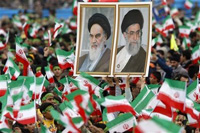Iran continues to develop speedily despite international isolation
Iran celebrates the 30th anniversary of the Islamic Revolution. Iran has been living under the conditions of international sanctions and under the threat of war for three decades already. The nation has achieved considerable progress despite those threats. The World Bank put Iran on the 17th place on the list of 180 countries, the GDP of which exceeds $776 billion. Such countries as Australia and Holland enjoy a lower rank on the list.

The world crisis did not cause much damage to Iran’s economy in comparison with other countries of the region. Iran’s President Mahmoud Ahmadinejad stated that the world financial crisis showed no influence on the nation’s budget because the economy of Iran was based on the country’s inner potential. Ahmadinejad proudly said that he would be able to govern the country even if oil prices dropped to five or seven dollars per barrel.
Ahmadinejad was not showing his bravado when he said that. Iran’s demonstrated crude reserves are evaluated at 138 billion barrels, which makes the country the fourth largest crude exporter in the world. At the same time, Iran suffers from a strong lack of fuel due to the shortage of refinery capacities. The nation’s daily output of gas amounts to 485 million cubic meters, which also places Iran on one of the leading positions in the world.
The Islamic Revolution represents a series of events from January 1978 to February 1979. The revolution transformed Iran from a constitutional monarchy of Shah Mohammad Reza Pahlavi to an Islamic Republic.
Pahlavi came to power in 1941. He was a US-oriented monarch who tried to westernize Iran for 38 years. Any opposition to the monarchy was strictly forbidden. Ayatollah Ruhollah Khomeini condemned the pro-Western policy of the shah. His arrest in 1963 triggered an outburst of actions of protest across the nation, in which over 15,000 people were killed. Khomeini was placed under house arrest, but he continued his anti-shah activities upon his release. He was eventually exiled from the country in 1964.
Pahlavi eased his repressions under the pressure of the United States in 1977 and released several hundreds of political prisoners who did not give up the ideas of building Islamic socialism.
The Iranian Revolution began on January 8, 1978, when the first anti-governmental demonstration was violently suppressed in the town of Qom. Seventy people were killed in the riots. The national economy had been eventually undermined by November 1978. Oil-production enterprises and ports came to a standstill, and over two million people took to the streets on December 2 in Teheran asking the shah to step down.
Shah fled Iran in January 1979. Iranian Prime Minister Bakhtiar contacted Khomeini and asked him to return to Iran to draw up the new Constitution. Khomeini returned to Iran on February 1, 1979 – millions of Iranians were happy to greet their leader. Khomeini’s followers took the control of the police and the military. The Iranian army subsequently declared neutrality.
The new Constitution of the country created the Supreme Leader post for Khomeini and empowered the president with civil authorities. The spiritual leader, Ayatollah, became the actual ruler of the nation, whereas the president was less powerful.
Iran is a bright example of paradox of history. It is being isolated, but the country continues to develop.
Vladimir Anokhin
Subscribe to Pravda.Ru Telegram channel, Facebook, RSS!

